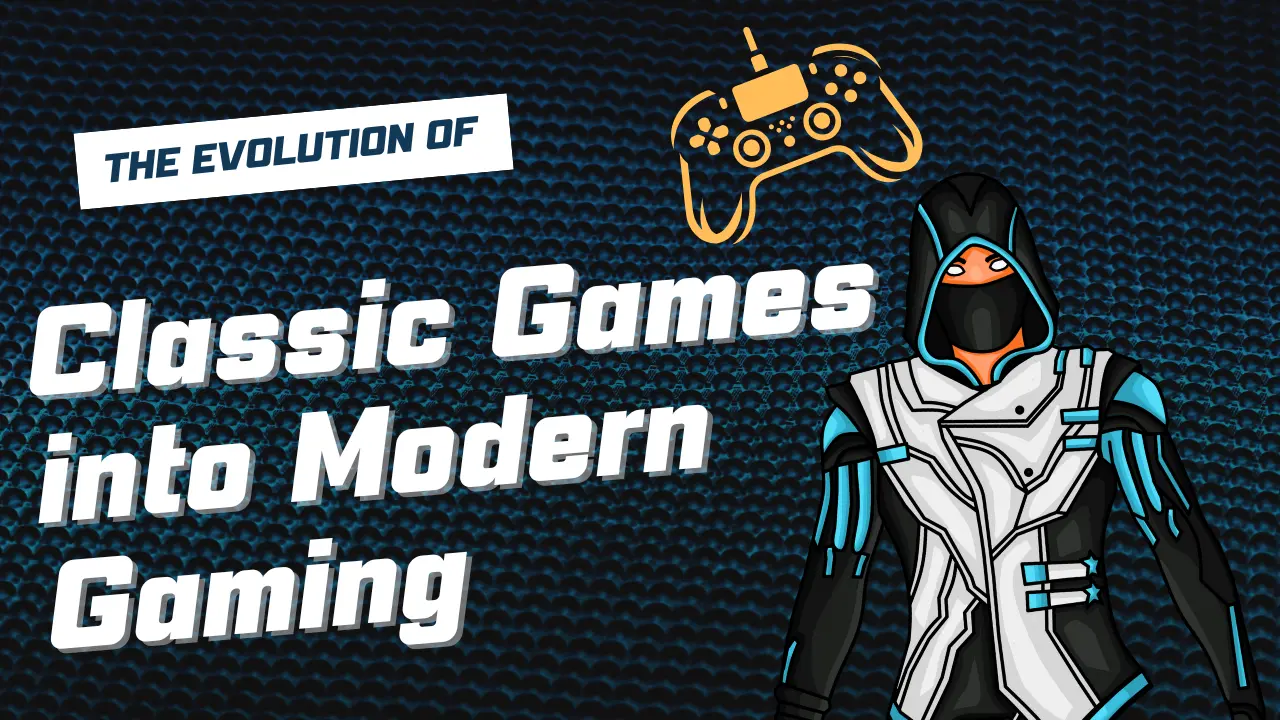From the pixelated arcades to the hyper-realism of the 3D world, it has been the most exhilarating ride for video games. The transition from popular classic games to contemporary gaming indicates not only technological advancement but also the evolution of taste among gamers around the globe. This article attempts to track the classic evolution of games, their influences on present-day gaming, and how a feeling of nostalgia still drives modern gaming.
What Are Classic Games?
Classic games refer to video games that were released between the dawn of gaming, roughly from the 1970s to the early 2000s. Some of these very popular ones are Pac-Man, Super Mario Bros., Tetris, The Legend of Zelda, and Sonic the Hedgehog. They most often referenced systems like the Atari 2600, NES, SNES, Sega Genesis, and early PCs.
While they did little to impress on the graphics or hardware front, these games paved the way for gaming culture today. Game design, storytelling, and pure brilliance underneath severe limitations are what immortalize these classic games.
The 1980s-The Era Remembered as the Golden Age for Arcade Gaming
The 1980s marked the golden age of arcade machines. The whole era saw the rise of coin-operated arcade machines in shopping malls, restaurants, and game centers. With games like Donkey Kong, Space Invaders, and Galaga, these were household names.
Key Features:
- Very basic graphics, highly addictive gameplay
- High-score systems were embedded to nurture intense competition
- Very basic sound effects and 8-bit music
In essence, it was really all about skill, reflexes, and repetition, whose game-design philosophy is very much incorporated in contemporary gaming mechanics.
The 1990s: Rise of Home Consoles and 16-bit Power
With the arrival of the powerful Super Nintendo Entertainment System (SNES) and Sega Genesis, gaming entered the homes of families around the world. The new decade was ushered in by games of platforming, RPGs, and fighting games such as Street Fighter II, Final Fantasy VI, and Chrono Trigger.
Technological Shifts:
- Better 16-bit graphics
- More character development and storyline
- Introduction of the save system and memory cards.
In a way, these games were precursors of the enduring franchises and laid the foundation for story-based gaming.
Early 2000s: The 3D Renaissance
The late ’90s and the early 2000s witnessed the next big leap, into the realm of 3D games. Consoles such as the Sony PlayStation, Nintendo 64, and Xbox dazzled players with gorgeous 3D environments.
Major Innovations:
- 3D characters and camera systems
- Voice acting and cinematic cutscenes
- Online multiplayer beginnings
Games such as Metal Gear Solid, Resident Evil, and Halo laid the groundwork for storytelling, AI, and gameplay realism.
Influences of Old School Games on the Modern Variety
Despite all the advancements, the DNA of old school games never died out and continues to inform modern gaming. Many modern titles pay homage to the retro style, while others rather directly remake an old game.
Examples:
- Retro-style indie games: Shovel Knight, Celeste, Undertale
- Remake and remasters: Resident Evil 2 Remake, Final Fantasy VII Remake
- Reboots of classic franchises: Doom, Crash Bandicoot, Zelda: Breath of the Wild
Such adaptations make sure that the old-school feeling remains alive while embracing the current technologies.
Graphics: From Pixels to Photorealism
The evolution in the quality of graphics is perhaps the most evident in gaming. Old classic games had 8-bit or 16-bit sprite-based graphics. Today, we are dealing with 4K resolutions, ray tracing, and motion capture animation.
Then vs. Now:
|
Element |
Classic Games |
Modern Games |
| Resolution | 240p or 480p | 1080p, 4K, even 8K |
| Graphics Style | Pixel/Sprite Art | 3D/Photorealistic |
| Sound | 8-bit soundtracks | Full orchestral scores |
| Input | Simple buttons |
Motion controls, VR |
Such a change will make the game more immersive, but will also require bigger computers and bigger development teams.
Evolution of Narrative and Game Design
Classic games had minimal narratives, usually appearing as text on the screen or in the form of short cutscenes. Modern storytelling, however, has become as much a part of game design as cinematography or literature.
Advancements to Storytelling:
- Branching narratives with several endings
- Choices impacting gameplay
- Emotional characters with complex arcs
The Last of Us, God of War, and Red Dead Redemption 2 serve as proof of the waters the storytelling has gone through.
Online Multiplayer and eSports on the Rise
Classic games were mostly single-player titles or, at best, local multiplayer. Modern gaming has embraced the notion of connecting players around the globe via online multiplayer.
Core online developments:
- Walloping multiplayer platforms (MMORPGs): World of Warcraft, Final Fantasy XIV
- Battle Royale games: Fortnite, Apex Legends
- eSports leagues and professional tournaments
Beginning just as friendly competition on arcade cabinets, eSports today is a multi-billion-dollar industry on a worldwide basis.
Accessibility and Platforms: Games Anytime and Everyplace
In good old times, games were typical of a specific platform. Now, games march across consoles, PCs, mobiles, or merely via cloud service providers such as Xbox Cloud Gaming or NVIDIA GeForce Now.
Main Changes:
– Cross-platform play
– Mobile gaming revolution
– Cloud-based streaming and game subscriptions
Great games cannot be bought cheaply anymore, nor do gamers require a huge-priced hardware!
What Roles Do Emulators and Retro Consoles Play?
The urge to maintain many titles remains high with the “assistance” provided by emulators, ROMs, and retro consoles. Old favorites are reaching new generations via devices like the NES Classic Edition, SNES Classic, and PlayStation Classic.
Even Nintendo permits subscription access to retro titles through a service called Nintendo Switch Online.
Why Classic Games Matter Still?
Classic games serve not simply as memory but represent the deep-seated history of modern-day gaming. They instilled the basic rules of design, challenge, and user engagement into creators. Working in their simplicity, these older games more often than not have more replay value; in spite of being old, the legacy continues to inspire other developers and even players alike.
From the familiar pixel plumber to Space Invaders, in a way, these classic games are articulators of ideas stating that fun needs no complexity.
Conclusion: A Legacy That Lives On
The transition of classic games into modern gaming is a story of invention, technology, and cultural growth. From blocky sprites to cinematic adventures, every generation has built upon the other and pushed the boundaries of the possible.
Modern games owe their existence to the classics that came before them. So, whether creating a brand-new AAA title or dusting off an old cartridge, you are participating in a rich, ever-evolving legacy.
So, next time you go gaming, think about how it all started with a handful of pixels and loads of imagination.

